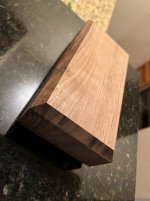pacificdune
Member
- Joined
- Apr 12, 2022
- Messages
- 19
Hi friends,
I have a project where I want to sand some fairly narrow 45 degree bevels. I have been thinking about getting an ETS 125 REQ with the edge sander for this reason, and this seems like a good enough excuse to pull the trigger.
In order to make the perfect kit for the application I also wanted a hard pad for the ETS125 REQ. After some searching online and in the forum it appears that (at least as of 2019) there was no hard pad available for this sander. Seems like you would want one, especially with the edge sanding kit available.
Is this still true? Does anyone have this setup? Would a hard pad be overkill, or have you been able to find a suitable hard pad for the ETS125 REQ?
Thanks!
Dune
I have a project where I want to sand some fairly narrow 45 degree bevels. I have been thinking about getting an ETS 125 REQ with the edge sander for this reason, and this seems like a good enough excuse to pull the trigger.
In order to make the perfect kit for the application I also wanted a hard pad for the ETS125 REQ. After some searching online and in the forum it appears that (at least as of 2019) there was no hard pad available for this sander. Seems like you would want one, especially with the edge sanding kit available.
Is this still true? Does anyone have this setup? Would a hard pad be overkill, or have you been able to find a suitable hard pad for the ETS125 REQ?
Thanks!
Dune

